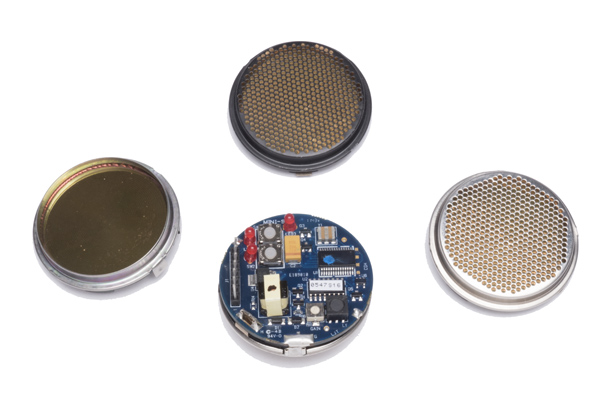Electrostatic devices have a higher sensitivity and bandwidth than piezoelectric devices. Electrostatic devices have a relatively flat response over a wide frequency range, and because they are non-resonant, have very low ring-out characteristics. Such devices are more sensitive than their piezo counterparts, typically by 40 dB or better.
The increased sensitivity translates into longer-range capabilities (or lower-gain receive circuits for shorter-range applications) and the ability to sense small and acoustically absorptive targets more reliably than piezo transducers. A single electrostatic transducer coupled with the proper electronic driver and receiver can cover a range of 1 inch to over 40 feet, making them a good choice for deep tank level measurement applications.
Performance characteristics are very stable over a wide operating temperature, typically -40° to 125°C, resulting in simple drive and receive circuits that do not have to be compensated for device drift over temperature, and enables the circuitry to be packaged in the sensor housing. For example, SensComp’s electrostatic Smart Sensor measures 1.6 (dia) x 0.75 in., making it a compact solution in tight spaces.
Electrostatics outperform piezoelectrics in all functional areas except for size and ruggedness.

Third party scientific confirmation of the benefits of electrostatics over piezoelectrics, and features SensComp’s products
Authoritative Robotics Reference Manual
The Springer Handbook of Robotics, 2nd edition, continues to be an authoritative reference for robotics researchers, newcomers to the field and scholars from related disciplines. It is a state of the art view of the rapidly developing field of robotics. The new generation of robots will increasingly touch people and their lives. The second edition was edited by two internationally renowned scientists, Prof. Bruno Siciliano and Prof. Oussama Khatib. In comparing electrostatic and piezoelectric transducers, they state “In general electrostatic devices have a higher sensitivity and bandwidth ….” P 497. Further, “Piezoelectric devices have a narrow frequency response compared to electrostatic transducers.” P 497. The examples of electrostatic transducers cited and pictured are those manufactured by SensComp (the Series 600, 7000 and 9000). Page 498.
Recognition of the credibility of SensComp’s electrostatic sensors in Robotics Textbook
Practical and Experimental Robotics, a recognized textbook on Robotics, features and describes SensComp’s ranging module and demonstrates in great detail how it can be used on a four-wheel drive robot. It confirms the oSonorPL object handles all the necessary I/O timing required to communicate with the SensComp ultrasonic range finder and measure the distance between the electrostatic transducer and its target.
Scientific Peer Reviewed Journal Prefers Performance of Electrostatics over Piezoelectrics
Newer MEMS transducers also offer the choice of electrostatic of piezoelectric. In The Journal of Physics, PowerMEMS 2015, the paper “Which is better, electrostatic or piezoelectric energy harvesting systems?”, finally answers the often asked but inadequately answered question. The paper concludes that MEMS’ electrostatics perform better than piezoelectrics at lower and higher accelerations, and thus, are preferred.
